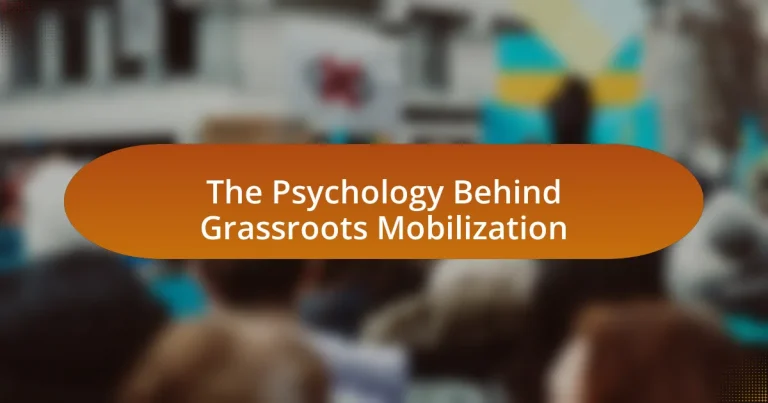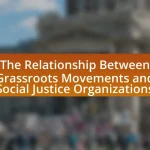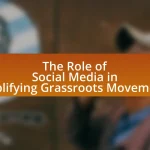The article explores the psychology behind grassroots mobilization, emphasizing the significance of social identity theory, collective efficacy, and emotional engagement in motivating individuals to participate in collective action. It discusses how strong group identities and emotional appeals can enhance mobilization efforts, while also addressing psychological barriers such as apathy and fear that hinder participation. Key factors contributing to successful grassroots mobilization, including community engagement, clear messaging, and effective leadership, are examined alongside the role of social networks and social media in facilitating mobilization. The article concludes with practical strategies for overcoming psychological barriers and enhancing grassroots efforts through effective communication and community building.
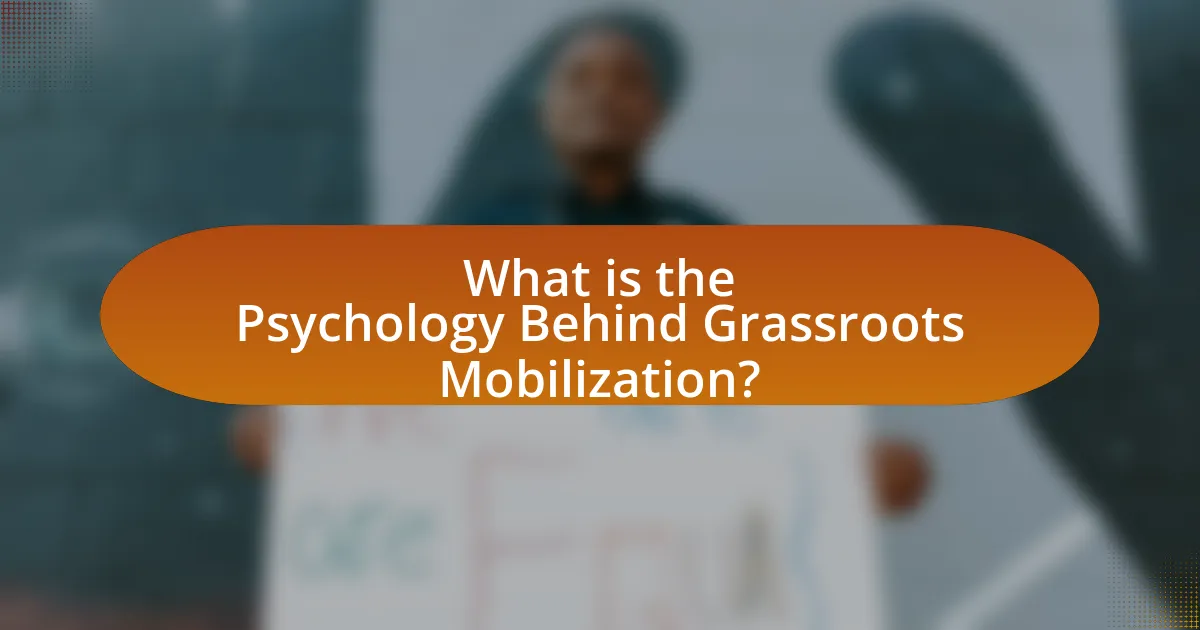
What is the Psychology Behind Grassroots Mobilization?
The psychology behind grassroots mobilization is rooted in social identity theory, which posits that individuals derive part of their self-concept from their group memberships. This connection fosters a sense of belonging and motivates individuals to engage in collective action for shared goals. Research indicates that when people identify strongly with a group, they are more likely to participate in mobilization efforts, as seen in studies like those conducted by Henri Tajfel and John Turner, which highlight the importance of group dynamics in influencing behavior. Additionally, emotional appeals, such as feelings of injustice or urgency, can further galvanize individuals to act, as demonstrated in various social movements where emotional narratives have successfully mobilized large numbers of participants.
How does psychological theory explain grassroots mobilization?
Psychological theory explains grassroots mobilization by emphasizing the role of social identity, collective efficacy, and emotional engagement in motivating individuals to participate in collective action. Social identity theory posits that individuals derive part of their self-concept from their group memberships, which can lead to increased solidarity and motivation to mobilize for shared goals. Research indicates that when individuals perceive themselves as part of a group with a common identity, they are more likely to engage in actions that support that group, as seen in studies on community organizing and social movements. Additionally, collective efficacy, the belief that a group can achieve its goals, enhances motivation and participation, as demonstrated in various grassroots campaigns where shared beliefs in the group’s capabilities led to higher levels of activism. Emotional engagement, including feelings of anger or hope, also plays a critical role in mobilization, as these emotions can drive individuals to take action, evidenced by the emotional narratives often used in successful grassroots movements.
What are the key psychological principles involved in mobilization?
The key psychological principles involved in mobilization include social identity, collective efficacy, and emotional appeal. Social identity theory posits that individuals derive part of their self-concept from their group memberships, which can motivate them to mobilize for causes that align with their group identity. Collective efficacy refers to the belief that a group can achieve its goals through coordinated action, which enhances motivation and participation. Emotional appeal, particularly through narratives and shared experiences, can galvanize individuals to take action by fostering empathy and urgency. These principles are supported by research indicating that group dynamics and emotional connections significantly influence mobilization efforts in grassroots movements.
How do emotions influence grassroots movements?
Emotions significantly influence grassroots movements by driving engagement, fostering solidarity, and motivating action among participants. Emotional responses, such as anger, hope, or fear, can galvanize individuals to join a cause, as seen in movements like the Civil Rights Movement, where collective anger against injustice mobilized thousands. Research indicates that emotional appeals in messaging can enhance participation rates; for instance, a study published in the journal “Social Movement Studies” found that emotionally charged narratives increased the likelihood of individuals joining protests. Thus, emotions serve as a catalyst for mobilization, shaping the dynamics and effectiveness of grassroots efforts.
Why is understanding psychology crucial for effective mobilization?
Understanding psychology is crucial for effective mobilization because it enables leaders to tap into the motivations, beliefs, and emotions of individuals. By comprehending psychological principles, mobilizers can craft messages that resonate with their audience, fostering a sense of belonging and urgency. For instance, research by Cialdini (2009) highlights the importance of social proof and reciprocity in influencing behavior, which can be leveraged to encourage participation in grassroots movements. Additionally, understanding cognitive biases allows mobilizers to anticipate and address potential objections, thereby enhancing engagement and commitment.
How can psychological insights improve mobilization strategies?
Psychological insights can enhance mobilization strategies by leveraging understanding of human behavior and motivation. For instance, insights into social identity theory reveal that individuals are more likely to mobilize when they feel a strong connection to a group. Research by Henri Tajfel and John Turner demonstrates that group identity can significantly influence participation levels in collective actions. Additionally, employing principles of behavioral psychology, such as the use of nudges, can effectively encourage individuals to take action by simplifying decision-making processes. A study published in the Journal of Personality and Social Psychology found that framing messages to align with individuals’ values increases engagement and participation rates. Thus, integrating psychological insights into mobilization strategies can lead to more effective and targeted approaches, ultimately increasing grassroots participation.
What role does group identity play in grassroots efforts?
Group identity plays a crucial role in grassroots efforts by fostering a sense of belonging and shared purpose among individuals. This collective identity enhances motivation and commitment to the cause, as individuals feel connected to a larger group working towards common goals. Research indicates that when people identify strongly with a group, they are more likely to engage in collective action, as evidenced by studies showing that group cohesion can significantly increase participation rates in social movements. For instance, a study published in the Journal of Personality and Social Psychology found that individuals who felt a strong group identity were more likely to mobilize for collective action, demonstrating the powerful influence of group identity on grassroots mobilization.
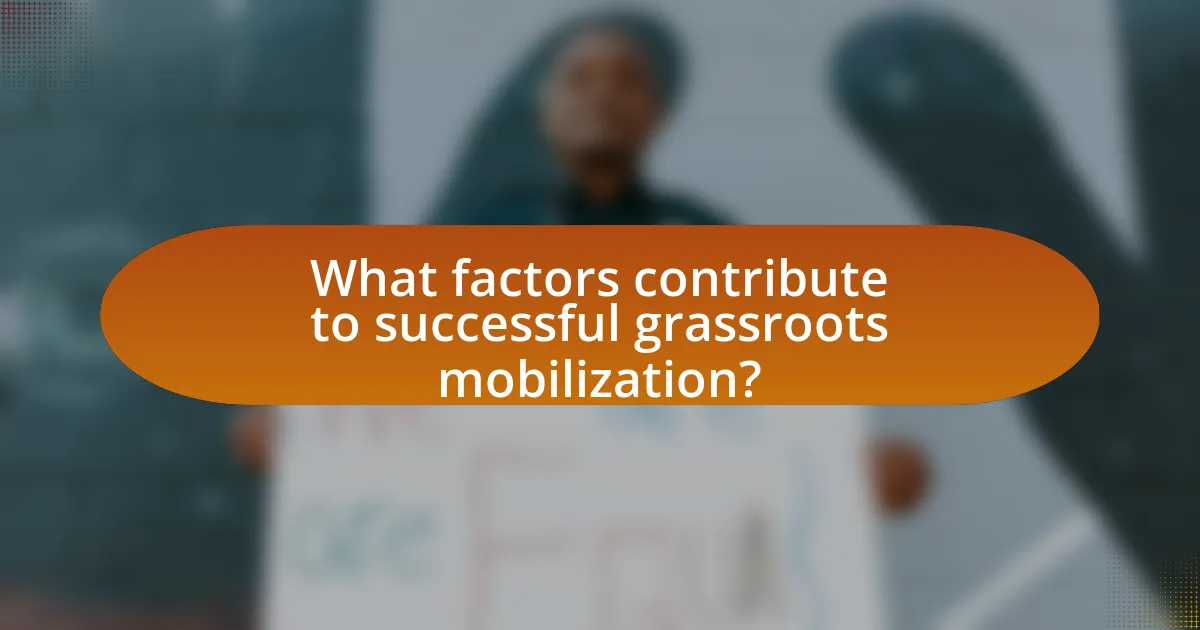
What factors contribute to successful grassroots mobilization?
Successful grassroots mobilization is primarily influenced by community engagement, clear messaging, and strong leadership. Community engagement fosters a sense of belonging and ownership among participants, which is essential for mobilization efforts. Clear messaging ensures that the goals and objectives are easily understood, allowing individuals to connect emotionally with the cause. Strong leadership provides direction and motivation, helping to organize efforts effectively. Research indicates that grassroots movements with high levels of community involvement and effective communication strategies are more likely to achieve their objectives, as seen in the success of movements like the Civil Rights Movement in the United States, which utilized these factors to mobilize large groups for social change.
How do social networks impact mobilization efforts?
Social networks significantly enhance mobilization efforts by facilitating rapid information dissemination and fostering community engagement. These platforms allow individuals to share messages, organize events, and rally support quickly, which is crucial during time-sensitive campaigns. For instance, research by the Pew Research Center indicates that 69% of adults in the U.S. use social media, providing a vast audience for mobilization messages. Additionally, social networks create a sense of belonging and collective identity, which can motivate individuals to participate in grassroots movements. A study published in the journal “Social Movement Studies” found that social media campaigns can increase participation rates by up to 30%, demonstrating their effectiveness in mobilizing individuals for collective action.
What types of social connections are most effective?
Effective social connections include strong ties, such as close friendships and family relationships, as well as weak ties, like acquaintances and professional contacts. Research indicates that strong ties provide emotional support and trust, which are crucial for mobilization efforts, while weak ties facilitate access to diverse information and resources, enhancing outreach and engagement. A study by Granovetter (1973) in “The Strength of Weak Ties” demonstrates that individuals with a mix of strong and weak ties are more likely to mobilize effectively, as they can leverage both emotional support and broader networks for action.
How does social media influence grassroots mobilization?
Social media significantly influences grassroots mobilization by facilitating rapid communication and community building among like-minded individuals. Platforms such as Facebook and Twitter enable organizers to disseminate information quickly, coordinate events, and rally support for causes, which enhances participation rates. For instance, the Arab Spring demonstrated how social media was instrumental in mobilizing protests and spreading awareness, leading to significant political changes in several countries. Research by the Pew Research Center indicates that 69% of adults in the U.S. use social media, highlighting its potential reach and impact on grassroots movements.
What psychological barriers exist in grassroots mobilization?
Psychological barriers in grassroots mobilization include apathy, fear of social repercussions, and perceived inefficacy. Apathy can stem from individuals feeling disconnected from the cause or believing their participation will not make a difference. Fear of social repercussions arises when individuals worry about negative judgment or ostracism from their peers for engaging in activism. Perceived inefficacy occurs when potential participants doubt their ability to effect change, leading to disengagement. Research indicates that these barriers can significantly hinder collective action, as demonstrated in studies on social movements where individuals reported feeling overwhelmed or powerless in the face of systemic issues.
How can fear and apathy hinder mobilization efforts?
Fear and apathy significantly hinder mobilization efforts by creating barriers to participation and engagement. Fear can lead to avoidance behaviors, where individuals refrain from joining movements due to concerns about personal safety, social repercussions, or failure. For instance, studies have shown that in environments where activists face threats or violence, participation rates drop sharply, as individuals prioritize their safety over collective action. Apathy, on the other hand, results in a lack of motivation or interest in social issues, causing potential supporters to disengage entirely. Research indicates that when individuals perceive issues as distant or irrelevant, their likelihood of mobilizing diminishes, as seen in voter turnout statistics where low engagement correlates with feelings of disconnection from political processes. Together, fear and apathy create a cycle that stifles grassroots movements, preventing them from gaining the necessary momentum to effect change.
What strategies can overcome these psychological barriers?
To overcome psychological barriers in grassroots mobilization, strategies such as fostering community engagement, building trust, and utilizing effective communication can be employed. Community engagement encourages participation by creating a sense of belonging and shared purpose, which has been shown to enhance motivation and commitment among individuals. Building trust within the group is essential, as studies indicate that trust increases collaboration and reduces resistance to change. Effective communication, including clear messaging and active listening, helps address concerns and misconceptions, thereby reducing anxiety and fostering a supportive environment. These strategies collectively create a conducive atmosphere for mobilization by addressing the underlying psychological barriers that individuals may face.
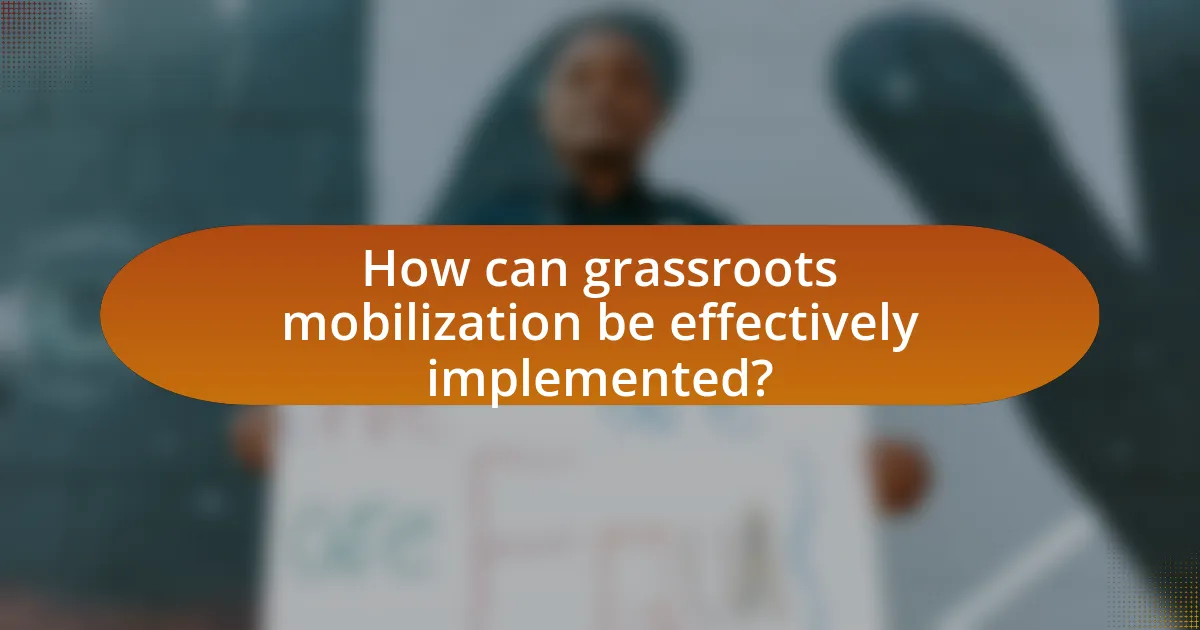
How can grassroots mobilization be effectively implemented?
Grassroots mobilization can be effectively implemented by fostering community engagement through clear communication and shared goals. Establishing a strong local network encourages participation, as evidenced by the success of movements like the Civil Rights Movement, where community leaders effectively organized and communicated objectives, resulting in significant social change. Utilizing social media platforms enhances outreach and mobilization efforts, allowing for rapid dissemination of information and coordination among supporters, as demonstrated by the Arab Spring, where grassroots movements gained momentum through digital communication.
What are the best practices for engaging communities?
The best practices for engaging communities include fostering open communication, building trust, and encouraging participation. Open communication allows community members to express their needs and concerns, which is essential for effective engagement. Building trust involves being transparent and consistent in actions, which helps to create a safe environment for dialogue. Encouraging participation can be achieved through inclusive events and activities that invite diverse voices, ensuring that all community members feel valued and heard. Research indicates that communities with high levels of engagement often see improved social cohesion and collective action, as highlighted in the study “Community Engagement: A Key to Successful Community Development” by the Community Development Society.
How can leaders foster a sense of belonging among participants?
Leaders can foster a sense of belonging among participants by creating inclusive environments that encourage open communication and collaboration. This involves actively listening to participants’ ideas and concerns, which research shows enhances group cohesion and individual commitment. A study published in the Journal of Personality and Social Psychology found that when leaders promote shared values and recognize individual contributions, participants feel more connected to the group. Additionally, implementing team-building activities can strengthen interpersonal relationships, further solidifying a sense of community.
What techniques can be used to motivate individuals to act?
Techniques to motivate individuals to act include setting clear goals, providing incentives, fostering a sense of community, and utilizing social proof. Clear goals help individuals understand what is expected and create a roadmap for action. Incentives, such as rewards or recognition, can enhance motivation by appealing to personal interests. A sense of community encourages collaboration and support, making individuals feel part of a larger purpose. Social proof, where individuals observe others taking action, can influence behavior by creating a perception of normativity. Research indicates that these techniques effectively increase engagement and participation in grassroots movements, as demonstrated in studies on behavioral psychology and community organizing.
What role does messaging play in grassroots mobilization?
Messaging plays a critical role in grassroots mobilization by shaping narratives that resonate with community values and motivating individuals to take action. Effective messaging creates a sense of urgency and belonging, which are essential for mobilizing support. For instance, research by the Stanford Social Innovation Review indicates that clear, relatable messaging can increase engagement by up to 50%, demonstrating its power in rallying individuals around a common cause. Additionally, messaging that emphasizes shared identity and collective goals fosters community cohesion, making it easier for grassroots movements to gain traction and influence.
How can messages be crafted to resonate psychologically with audiences?
Messages can be crafted to resonate psychologically with audiences by utilizing principles of emotional appeal, social proof, and cognitive biases. Emotional appeal engages audiences by evoking feelings such as empathy or urgency, which can drive action; for example, research shows that emotionally charged messages can increase persuasion by up to 50%. Social proof leverages the tendency of individuals to look to others for guidance, making testimonials or community endorsements effective in reinforcing a message. Additionally, cognitive biases, such as the framing effect, can influence how information is perceived; presenting a message in a positive light can significantly enhance its impact. These strategies are supported by psychological theories, including the Elaboration Likelihood Model, which emphasizes the importance of emotional and rational processing in persuasion.
What are the most effective communication strategies for mobilization?
The most effective communication strategies for mobilization include clear messaging, targeted outreach, and the use of social media platforms. Clear messaging ensures that the core message is easily understood and resonates with the audience, which is crucial for motivating individuals to take action. Targeted outreach involves identifying and engaging specific groups that are likely to support the cause, thereby increasing the likelihood of mobilization. The use of social media platforms allows for rapid dissemination of information and facilitates community building, as evidenced by the success of movements like the Arab Spring, where social media played a pivotal role in organizing protests and spreading awareness.
What practical tips can enhance grassroots mobilization efforts?
To enhance grassroots mobilization efforts, organizations should prioritize building strong community relationships. Establishing trust and rapport with community members fosters engagement and encourages participation. Research indicates that grassroots movements with deep local ties are more effective; for instance, the 2011 Occupy Wall Street movement gained traction through local assemblies that empowered individuals to voice their concerns and collaborate on solutions. Additionally, utilizing social media platforms effectively can amplify outreach and mobilization, as seen in the Arab Spring, where social media played a crucial role in organizing protests and spreading awareness. Engaging volunteers through training and leadership opportunities also strengthens grassroots efforts, as empowered individuals are more likely to take initiative and inspire others.
